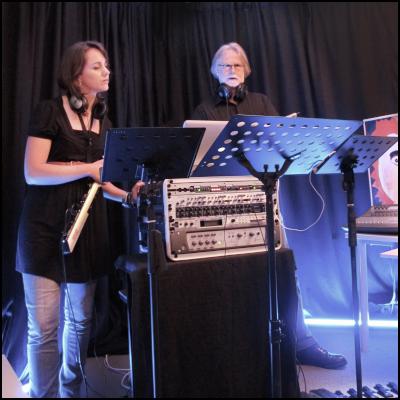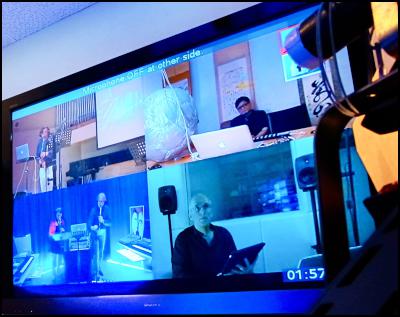Internet2 and IPV6 provide new opportunities for music

Ian Whalley (wind controller, Max/MSP patches, foot controller synthesiser programming) and Hannah Gilmour (wind controller, drones, tuis) linking with musicians in Singapore and China.
18
November, 2011
New technologies – new music
University of Waikato musicians in Hamilton
used high-speed Internet2 and IPv6 format to link digtial
video and audio and open this year’s Asian Telemusic
Concert at the Musicacoustica festival live in
Beijing.
Composer, Associate Professor Ian Whalley, and research assistant Hannah Gilmour played with musicians who were based in Singapore and China. They used five digital video channels and multiple stereo channels, to link the performers in the three countries. The work also used data control from Singapore to trigger instruments in Hamilton and the performance was watched on a big screen by the audience in Beijing.
Composer Ian Whalley says combining audio and data control interactively through the high speed network allows for new forms of music and performance.
His work for the Musicacoustical Festival work was called KishiKaisei. The title is understood in Japanese as “to come out of a desperate situation and return to life”.
Structurally, the work evolves in five waves; three that build to collapse and two that slowly die out. .

Screen Shot. Playing Ian Whalley's work live. Bruce Gremo in Beijing (top left) for Musicacoustica11 Beijjing; Hannah Gilmour and Ian Whalley (bottom left) in Hamilton, Lonce Wyse in Singapore. Top Right Yu-chung Tseng monitoring in Taiwan.
Whalley says this latest performance builds on prior work he did last year that used acoustic instruments in combination with intelligent machine applications. “This new work is based on digital instrument software and sound programming, which is then played through real-time controllers.
“We used three sound-based wind instrument-based controllers playing between Hamilton and Beijing interactively to form the basis of the work. In addition, other sounds at Waikato were manipulated by the Singapore player by sending performance data over the network.”
Walley says with high-speed broadband, one’s physical location becomes of less importance than telepresence. “It’s about what one can do in the new physical/virtual space, and how one can combine the input of others in a meaningful way across countries.”
Whalley’s research into interactive machine/human net-based performance also involves ‘machine agent’ approaches to music where computers move from being controllers or reactors to active participants.
ENDS


 NZ Trucking Association: TruckSafe New Zealand Launches | A Game-Changer For Heavy Vehicle Safety And Compliance
NZ Trucking Association: TruckSafe New Zealand Launches | A Game-Changer For Heavy Vehicle Safety And Compliance Gaurav Mittal, IMI: How Can We Balance AI’s Potential And Ethical Challenges?
Gaurav Mittal, IMI: How Can We Balance AI’s Potential And Ethical Challenges? Science Media Centre: Several US-based Environmental Science Databases To Be Taken Down – Expert Reaction
Science Media Centre: Several US-based Environmental Science Databases To Be Taken Down – Expert Reaction Consumer NZ: Despite Low Confidence In Government Efforts, People Want Urgent Action To Lower Grocery Bills
Consumer NZ: Despite Low Confidence In Government Efforts, People Want Urgent Action To Lower Grocery Bills NZ Banking Association: Banks Step Up Customer Scam Protections And Compensation
NZ Banking Association: Banks Step Up Customer Scam Protections And Compensation The Reserve Bank of New Zealand: CoFR Seeking Feedback On Access To Basic Transaction Accounts
The Reserve Bank of New Zealand: CoFR Seeking Feedback On Access To Basic Transaction Accounts



